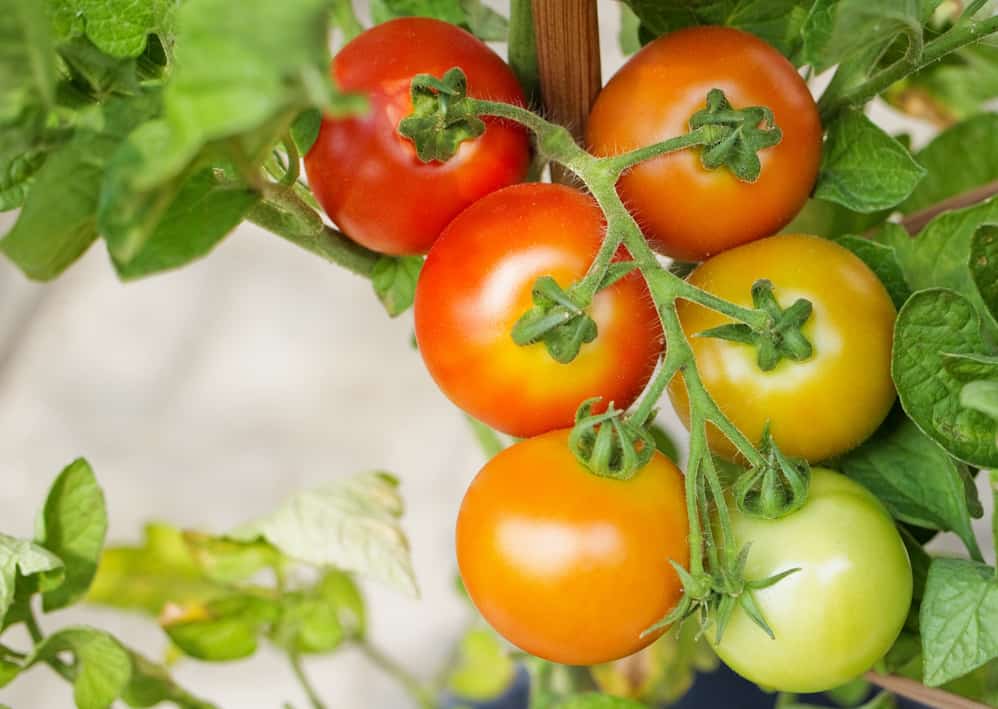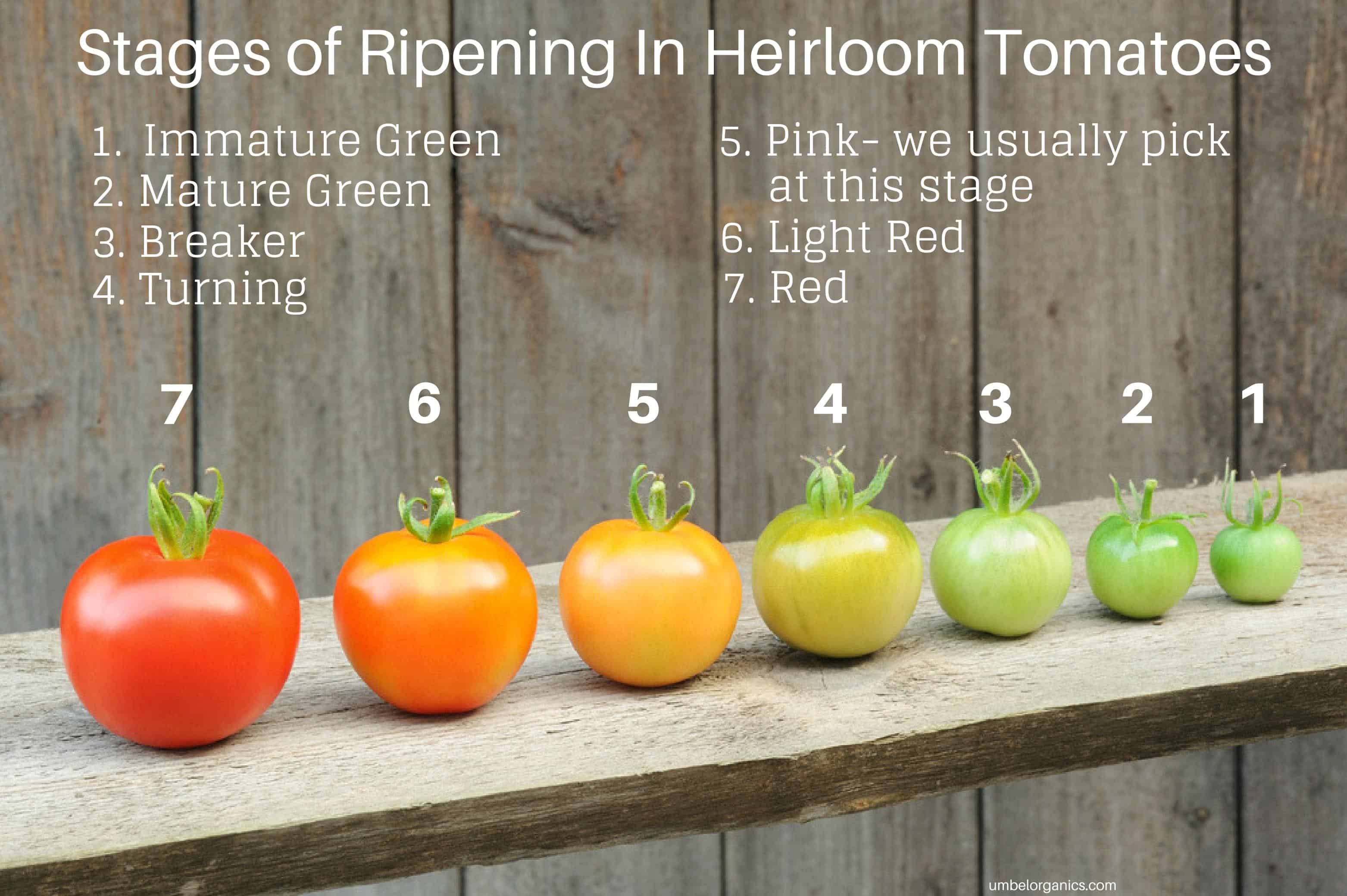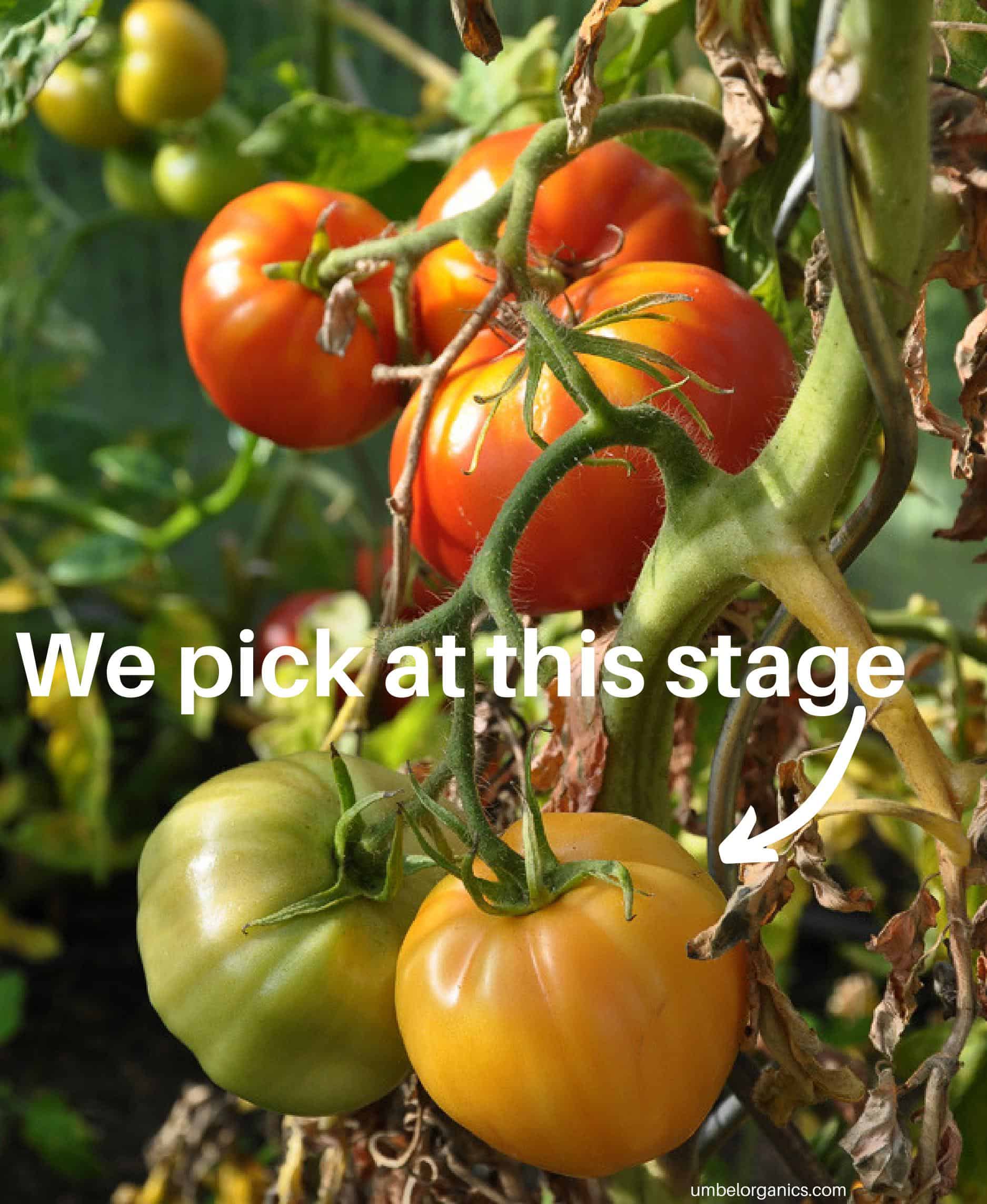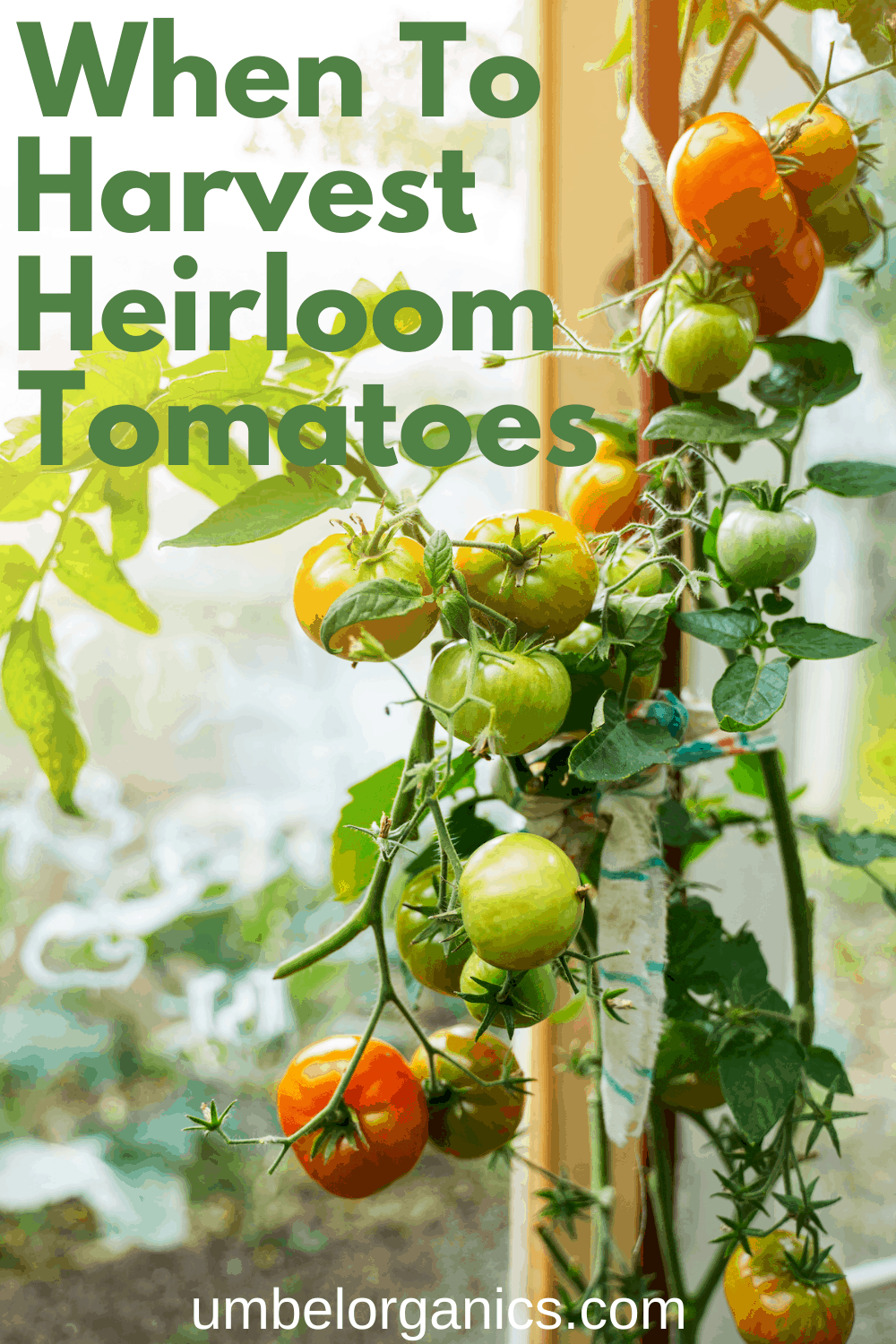When Should I Harvest Or Pick My Heirloom Tomatoes?
Are you waiting until your heirloom tomatoes are fully ripened to pick? From avoiding splitting to critter theft, there are many benefits to picking them earlier. Discover the best stage to harvest heirloom tomatoes and when they’re ready to eat.

Disclosure: This post contains affiliate links, which means if you make a purchase through these links, we may receive a small commission at no extra cost to you.
Like many gardeners, we once bought into the myth of the vine ripened tomato. When we first started growing tomatoes, we used to leave fruit on the vine and pick at the peak of ripeness.
Through research and experimentation over the years, we’ve learned that picking tomatoes before they are fully ripe (letting them ripen inside) does not adversely affect flavor, and there are actually some major benefits to harvesting them early.
Risks Of Leaving Tomatoes On The Vine Until Ripe
- Splitting/cracking: Splitting of tomato skin is caused by a sudden change in moisture. A rapid increase in water levels causes the inside of the tomato to swell faster than the skin can stretch, resulting in cracks. Splitting is common after a hard rain, especially if it has been dry previously. Unfortunately, many varieties of heirloom tomatoes are particularly prone to splitting. Since we can’t control mother nature, harvesting a tomato before it ripens minimizes the risk of splitting due to unforseen changes in moisture levels. If your tomatoes do split, harvest them as soon as possible. Split tomatoes are susceptible to rot and parasites.
- Sun scald: A telltale sign of sun scald is pale white or yellowish blotches on the side of a tomato where the sun is most intense. If tomatoes are exposed to direct sunlight, they may develop sun scald. Maturing tomatoes are susceptible to this condition, so harvesting early can help to reduce the risk of sun scald.
- Cold Weather: Autumn nights can get pretty chilly in Colorado (low 50s or below). Cool temperatures are not good for tomatoes. Not only can it cause slow, uneven ripening but it also has a negative impact on fruit quality and flavor. Bringing tomatoes indoors before they are fully ripe ensures that they won’t be exposed to cold or extreme temperature swings during the ripening process. This means even ripening and high quality flavorful tomatoes.
- Hot Weather: Just as cold can damage tomatoes, extreme hot weather can inhibit ripening.
- Insect attacks: Insects like the stink bug feed on ripening tomatoes. Harvesting fruit before it ripens minimizes insect damage.
- Thievery: We have a constant supply of pesky squirrels in our yard. They love taking one bite out of each tomato and discarding them. When the tomatoes turn a vibrant red, the squirrels mistake them for apples (that’s my theory). They’re pretty disappointed after a bite or two. By picking our tomatoes before they fully ripen, we get to them before the squirrels do.
Stages Of Ripening
Tomatoes go through several developmental stages on their way to becoming fully ripe. A critical point in this process is the “breaker” stage, the point at which you see the first traces of color, usually toward the blossom end. At this point, the tomato will ripen naturally, even if you remove it from the plant.
The 7 Stages of Tomato Ripening
- Immature green
- Mature green
- Breaker
- Turning
- Pink
- Light Red
- Red
The tomato starts out green, but slowly loses the green color from the chlorophyll. As carotenoids and lycopene develop in the fruit, the tomatoes reach their end-stage colors. Most ripening tomatoes will change green hues first, followed by an almost yellow color.
At the breaker stage, the tomato will start to develop streaks of color down at the blossom end. Tomatoes that have reached the breaker stage will finish ripening up off the vine.

Will Picking Tomatoes Before They Are Ripe Negatively Affect The Flavor?
This long held belief rests on the idea that the vine continues to provide the ripening tomato with nutrients and flavor compounds all the way up until it is fully ripe. On the other hand, we’ve seen claims that upon reaching the breaker stage, the fruit is sealed off from the plant and is no longer supplied with resources that affect flavor or quality.
Jeremy has sifted through the scientific literature to try and settle this debate. This was surprisingly difficult because not many studies have directly addressed this question. In a nutshell, while there is some evidence that the vine can continue to transfer resources to the fruit during ripening, the vast majority of resources are already there at the breaker stage (1,3), and one study (2) shows that transfer stops a few days after the breaker stage.
When To Harvest
Given this evidence we usually harvest during the “pink” stage, letting the tomatoes fully ripen indoors after picking. For us, there is no perceptible effect on flavor or fruit quality with this method.
We’ve done side-by-side taste comparisons, and, personally, can’t detect a difference in taste between vine-ripened tomatoes and those harvested at the pink stage and left to ripen inside after picking. Since we detect no differences in flavor, it makes sense to pick early in order to avoid the problems discussed above. Give it a try to see if it works for you.

How To Pick An Heirloom Tomato From The Vine
DON’T reach with one hand, grab and pull! Picking is a two-handed process. One hand holds the stem just above the fruit. Your other hand gently pulls the fruit from the vine. You may need to twist the tomato slightly as you pull it to ensure it will release easily from the vine.
OR we use garden scissors to snip the vine right above where it meets the fruit.
Both methods reduce the risk of breaking off a large part of the vine when picking a tomato.
How To Store Unripened Tomatoes
We store the unripened tomatoes in a large, shallow ceramic dish in the kitchen. The dish sits on a table that’s not in direct sunlight. It’s fine to keep them on your kitchen counter as long as the room temperature stays between 65-75°F.
AVOID placing unripened tomatoes in direct sunlight. They do not need light to ripen. High temperatures can inhibit ripening.
DO NOT store them in the refrigerator! Cold temperatures will make them mealy and ruin their flavor.
How To Tell If A Tomato Is Ready To Eat
Heirloom tomatoes come in all different shapes, colors and sizes, so a uniformly red tomato is not a surefire way to tell that a garden tomato is ripe. Here are some indicators that we use when deciding whether an heirloom tomato is ready to eat:
- Check the color on the bottom of the tomato– the darker it is, the riper it is.
- What variety are your heirlooms? Red varieties should be a deep red when ripe, yellow varieties should be a deep yellow, and so on.
- Tomatoes ripen from the inside out. A ripe tomato will give slightly to the touch. Be careful not to press too firmly. Use a very light squeeze with your fingers, and the outside of the tomato should give a little.
- Some varieties, particularly black tomatoes, tend to have green color on the shoulders, even when they are fully ripe. If the rest of the tomato appears to be fully ripe, go ahead and eat it.

More Gardening Inspiration
- New To Gardening? Start Here
- Tips For Growing The Best Tasting Strawberries
- Get An Early Start On Growing Tomatoes
- Tips For Growing Herbs In Containers
- Tips For Growing The Best Tasting Strawberries
- How To Grow Heirloom Tomatoes
- Tips For Growing Herbs In Containers
- How To Grow Garlic
- How To Grow Lettuce
References
- Badejo, A.A.Translocation and the alternative D-galacturonate pathway contribute to increasing the ascorbate level in ripening tomato fruits together with the D-mannose/L-galactose pathway. J Exp Bot. 2012 Jan;63(1):229-39.
https://www.ncbi.nlm.nih.gov/pubmed/21984649 - McCollum, J.P. and Skok, J. Radiocarbon studies on the translocation of organic constituents into ripening tomato fruits. Proceedings. American Society for Horticultural Science 1960 Vol.75 pp.611-16.
https://www.cabdirect.org/cabdirect/abstract/19610300839 - Zoltan, P. et al. Color Changes and Antioxidant Content of Vine and Postharvest-ripened Tomato Fruits. HortScience. Volume 45: Issue 3. pp 466–468. Mar. 2010.
https://journals.ashs.org/hortsci/view/journals/hortsci/45/3/article-p466.xml
top image via depositphotos





This is a really helpful post, thank you! We have both squirrels and chipmunks foraying onto our patio and I’m looking for all possible ways to protect my five tomato plants from them. I’ve been curious about the research on when tomatoes can be harvested while still retaining their flavor. I hadn’t heard about the breaker stage before.
I caught a chipmunk digging in the heirloom plant grow bags and I’m trying a mulch later and red chilli flakes first to see if that keeps them away. And if not, I plan to invest in some 1/2″ landscaping mesh to lay down in the soil to prevent digging. Another idea I hope to try to confuse the birds is to hang red Christmas ornaments on the caging to trick the birds into thinking my tomatoes aren’t edible. Fingers crossed we can get at least some fruits this summer!
mulch layer, not later!
Hi JoAnne-
It sounds like you have a lot of pests to contend with! Let us know if the red chili flakes or landscaping mesh works. We have a pvc cage around our tomato plants and we cover the cage with summer-weight fabric row covers. This keeps the pests out, but the Christmas ornaments sound like a great idea- your garden will be the most festive one around!
Happened upon your sight while looking for info on heirloom tomatoes. We didn’t plant them, but finally realized that’s what we have. Sure glad we found your info because it was time to pick them. Thank you, thank you! We are now following you.
Thanks Marsha- what a lucky find!